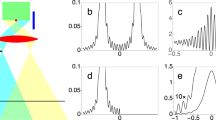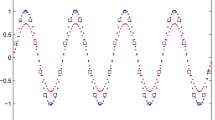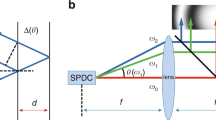Abstract
MEASUREMENTS of the distribution of light intensity in the images of a star, formed by lenses, may be made with photomultiplier techniques. The experimental evidence so provided is of immediate application to the theory of the resolution of optical instruments, permitting confirmation of rigorous calculations, for example, those of Airy1 for the aberration-free axial case, of Martin2 for the axial case with aberration and of Hopkins3 for the general case at a position in the field of a system with aberrations. Another use for these measurements is in checking the accuracy of approximate methods of image calculation4. Apparatus based on photomultipliers has generally been designed to employ a slit probe, for facility of image location and in order to keep the incident flux at a convenient level. Results have been obtained by Ingelstam5, Schade6, Lindberg7 and Sprosen8 in this way, and R. E. Hopkins9 has used a circular aperture to measure the proportion of the total energy which falls within a chosen diameter of the image. The measurements made by these means need to be converted by the appropriate mathematical techniques in order to arrive at the requisite distributions. Direct intensity distribution measurements are evidently desirable provided the experimental difficulties of image location and low light level can be overcome.
This is a preview of subscription content, access via your institution
Access options
Subscribe to this journal
Receive 51 print issues and online access
$199.00 per year
only $3.90 per issue
Buy this article
- Purchase on Springer Link
- Instant access to full article PDF
Prices may be subject to local taxes which are calculated during checkout
Similar content being viewed by others
References
Airy, Sir George, Trans. Camb. Phil. Soc., 5, 283 (1834).
Martin, L. C., “Technical Optics”, 1, 125 (Pitman, London, 1948).
Hopkins, H. H., Proc. Roy. Soc., A, 217, 408 (1953).
Bracey, R. J. (publication confidential to B.S.I.R.A.). Naish, J. M., and Mathieson, B. M., R.A.E. Technical Notes Ph. 482 and 484, Fig. 11 (1953).
Ingelstam, E., Proc. Symp. on Image Evaluation, Nat. Bur. Stands. (1951).
Schade, O. H., J. Soc. Mot. Pict. Telv. Eng., 56, 137 (1951); 58, 181 (1952).
Lindberg, P. J., J. Opt. Soc. Amer., 42, 748 (1952).
Sprosen, W. N., B.B.C. Quart., 8 (1) (1953).
Hopkins, R. E., Proc. Symp. on Image Eval., Nat. Bur. Stands. (1951).
Martin, L. C., “Technical Optics”, 2, 261 (Pitman, London, 1948).
Author information
Authors and Affiliations
Rights and permissions
About this article
Cite this article
NAISH, J., JONES, P. Direct Measurement of Intensity Distributions in Star Images. Nature 173, 1241–1242 (1954). https://doi.org/10.1038/1731241a0
Issue Date:
DOI: https://doi.org/10.1038/1731241a0
Comments
By submitting a comment you agree to abide by our Terms and Community Guidelines. If you find something abusive or that does not comply with our terms or guidelines please flag it as inappropriate.



